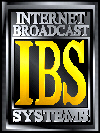




The Livecam Video Streaming ProjectThis project started in 1995 and continued till 2001, a total of 6 years. In that time It was started as a collaboration between Sokol & Associates andThe Original Livecam.com domain has been sold off; I have moved whatever was left there to livecamserver.com The first live cam was the Venice Beach Cam, and another in Santa Monica overlooking the Beachs. Then the Yosemite Glacier peak and Tahiti livecam's. These used a 486 with a Dycam serial port camera to snap still images and upload them very 3 minutes to an ftp site over the internet so a website would always have a current photo on the site. Photos from the original Livecam server. This later led to a collaboration with Xing Streamworks on their first internet streaming product. IBS has it's own version of the Xing server specialized for security and E-commerce for use in the adult industry. Due to problems with the Xing architecture, IBS developed it's first Full Motion JPEG codec using a Zoran hardware compressor. Using this system it was able to broadcast several live video streams to 30,000+ viewers live 24/7 in early 1997. IBS became the video suppler to the top 2500 adult web sites at that time. After trying to expand into europe and Asia, we developed a PC based system on 90 Mhz Pentiums that used a dumb frame grabber (matrox Meteor) with FreeBSD unix. During this time much of my earier work came together to build a server that could deliver 4000 simulations viewers, a global content disribution network of 20 locations around the world. Improved transmission protocols ECIP and SPAC were developed as well as the Afterburned high performace web server. Also other video codecs based on wavelet and fractal were developed and evaluated, but a breakthough in reducing the size needed for a high quality jpeg allowed it to become a very successful product in spite of the stigma JPEG had. Some people seeing better fast compression using JPEG then MPEG still couldn't get over there preconseptions of JPEG being inefficient. In March 14 1997 a livecam server was placed in Sri Lanka, used SPAC protocol to relay the video feed 1/2 way around the world to Chigago then rebroadcast to over 3000 viewer live. For and event at UIUC with Arthur C. Clarke. A framerate of 3 FPS was achived over a 64K line with a PING loss of 90%! a modem was needed to login to the remote server to start the video broadcast.
Here are some links to the older livecam sites when is was in it's prime, These are no longer active. http://www.dnull.com/videotechnology Remains of what used to be on videotechnology.com DVBS stuff is now at http://www.dnull.com/dvbs More DVBS sites http://www.dnull.com/vv |




